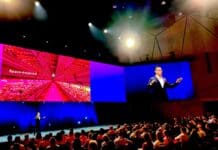
Scott Amyx will speak to the European Commission and participate in an exploration workshop in the framework of the “Study on Cross-Cutting Business Models for IoT” on Monday 30 January 2017 , in the Directorate General Communications Networks, Content and Technology (DG CONNECT) building of the European Commission in Brussels, Belgium.
The exploration workshop is meant to gather experts from different Internet of Things domains in order to discuss and deepen our preliminary findings on business models and the current market landscape and to explore additional aspects impacting the operations of companies and organisations active in this sector.
Internet of Things (IoT) merges physical and virtual worlds, creating smart environments. For the past six years, the European Commission has been actively cooperating with the industry and various organisations as well as with EU Member States and third countries to unleash the potential of the IoT technology.
Internet of Things (IoT) represents the next step towards the digitisation of our society and economy, where objects and people are interconnected through communication networks and report about their status and/or the surrounding environment. According to a European Commission study the market value of the IoT in the EU is expected to exceed one trillion euros in 2020.
Europe’s IoT Policy
In the last two years a set of supporting policy actions have been adopted by the European Commission to accelerate the take-up of IoT and to unleash its potential in Europe for the benefit of European citizens and businesses.
In March 2015 the Alliance for Internet of Things Innovation (AIOTI) was launched by the European Commission to support the creation of an innovative and industry driven European Internet of Things ecosystem. This flags the intention of the European Commission to work closely with all Internet of Things stakeholders and actors towards the establishment of a competitive European IoT market and the creation of new business models. Today AIOTI is the largest European IoT Association.
In May 2015 the Digital Single Market (DSM) Strategy was adopted. The DSM strategy includes elements which lead Europe a step further in accelerating developments on Internet of Things. In particular, the strategy underlines the need to avoid fragmentation and to foster interoperability for IoT to reach its potential.
To meet the DSM strategy needs and inform about its upcoming policy, the European Commission published in April 2016 the staff working document “Advancing the Internet of Things in Europe”. This document is part of the “Digitising European Industry (DEI)” initiative and specifies the EU’s IoT vision which is based on three pillars:
- A thriving IoT ecosystem
- A human-centred IoT approach
- A single market for IoT
A potential obstacle for the achievement of a single market for the IoT has to do with issues linked to the capacity to handle a large diversity and very large volumes of connected devices, and the need to securely identify them and be able to discover them so that they can be plugged into IoT systems. In this context it is important to promote an interoperable IoT numbering space for a universal object identification that transcends geographical limits, and an open system for object identification and authentication. Some aspects of numbering are already addressed in the 2016 review of the EU telecoms rules.
The recently proposed “European data economy” initiative (January 2017) also contributes to the creation of a European single market for IoT. This initiative proposes policy and legal solutions concerning the free flow of data across national borders in the EU, and liability issues in complex environments such as the IoT one. Especially, liability is decisive to enhance legal certainty around the IoT products and services.
In addition to the policy initiatives the EU has set up concrete IoT research and innovation objectives in the ongoing Horizon 2020 programme.
Source: European Commission.


















